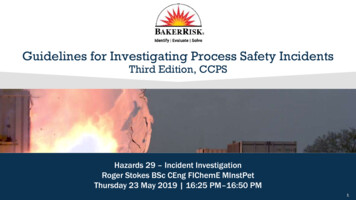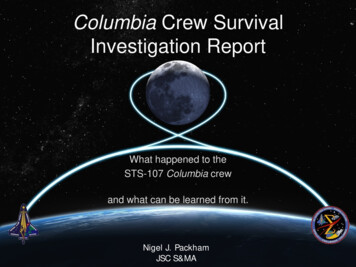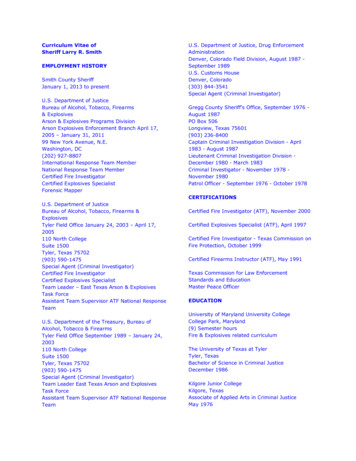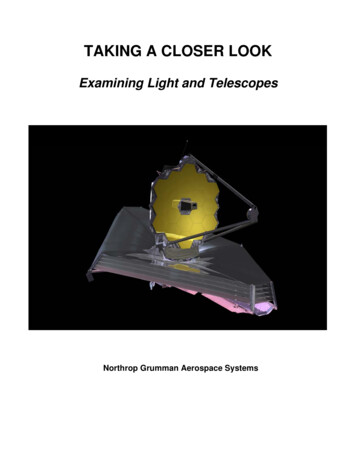
Transcription
3Investigation of the ‘tiger skin’ defecton indefinite chill rollsby J. Jonck*, J.S. Moema*†, J. Jooste‡ and P. van Tonder§Hot strip mills (HSMs) are used to roll steel slabs down from their initialsize to plate or sheet, which are then used to manufacture a wide varietyof goods for various industrial markets. The surface quality of the rollsthat contact and deform the strip must be maintained during rolling, asroll imperfections can be imposed onto the strip, affecting the quality. Formany years various roll producers have experienced the occurrence of asurface defect, commonly referred to as ‘tiger skin’ (TS), on indefinite chill(IC) work rolls, but the cause of the defect has not been thoroughlyinvestigated. The characteristics of the TS defects on the roll surface werestudied in an attempt to identify the cause and prevent its occurrence. Inthis paper, the characterization results of the defects are highlighted.Various techniques were utilized in the analysis: visual inspection,chemical analysis, optical microscopy, hardness testing, scanning electronmicroscopy and X-ray diffraction. The purpose of the testing was toidentify any variations in the roll microstructure that could give rise to thesurface variation. The results confirmed that the TS defects appeared as apattern that is not related to a variation in the surface profile, surfacecracking, chemical segregation, graphite characteristics, carbide characteristics, primary phase characteristics, bulk hardness, or microhardness.Further investigations are recommended. ; *58/3rolling, mills, hot strip, surface defects, ‘tiger skin’.6785/-27:56Hot strip mills (HSMs) are used to roll caststeel slabs from their initial size to plate orsheet, which is then used to manufacture awide variety of goods for various industrialmarkets. The working rolls that contact anddeform the strip are arguably the primaryelement of the HSM. The surface quality of therolls must be maintained during rolling asimperfections are imposed onto the strip,affecting the quality. Among these rolls areindefinite chill (IC) work rolls. The general ICroll chemistry and microstructure compareswell with traditional white cast iron, except forthe sulphur and phosphorus impurityelements, which are kept to lower levels andthe presence of some graphite in themicrostructure similar to the other cast ironssuch as gray and ductile cast iron.Various roll producers have experiencedthe occurrence of a surface defect on IC workrolls for many years, but the root cause of thedefect has not been thoroughly investigated. VOLUME 116 92(185-6/Following discussions with both HSMs and theSouth African Roll Company (SARCO) inFebruary and March 2012, the opinion wasthat while the TS defects appeared to belimited to IC work rolls, these were sourcedfrom various reputable global roll producers.The TS defects appear as minor variations inthe surface appearance of the roll, which canbe difficult to identify, as shown in Figure 1.The TS defect is transferred to the strip duringrolling and is classed as an aestheticallyundesirable defect by the steel mill. While inservice, TS is readily detected on the productby strip surface quality monitoring systems.The TS problem occurs intermittently and doesnot appear to correspond to specific periods orseasons. TS has been found in both singlestand reversing Steckel mills and multiplestand continuous mills and at both carbonsteel and stainless steel mills (van Tonder,2012).SARCO also indicated that the TS appearedwithin a specific layer of the shell (the outerportion of the composite roll) thickness, whichis typically at the roll surface after approximately 70% of the roll’s performance life. The* Mintek, Randburg, South Africa.† University of Pretoria, Pretoria, South Africa.‡ Vaal University of Technology, Vanderbijlpark,South Africa.§ South African Roll Company Pty. Ltd.,Vanderbijlpark, South Africa. The Southern African Institute of Mining andMetallurgy, 2016. ISSN 2225-6253. This paperwas first presented at the AMI Ferrous and BaseMetals Development Network Conference 201619–21 October 2016, Southern Sun ElangeniMaharani, KwaZulu-Natal, South Africa. 907L) 65 3:3The defect has been commonly referred to as‘tiger skin’ (TS) or elephant skin (van Tonder,2012). In this research, the characteristics ofthe TS surface defect were studied in anattempt to identify and remedy the cause.
Investigation of the ‘tiger skin’ defect on indefinite chill rolls%:1-8; ! :3-90 9 ;98962; 5. 74; 7:1;8 3(:6 # )" 3-8.92; /;.;27 56 96 *58( 8500TS appears only within the roll area that is in contact with thestrip during rolling. The surface can be ground to remove theTS, but the defect commonly reappears when the roll resumesservice. If TS is detected on a roll, a sufficient amount of shellmaterial will be removed (based on recommendations fromthe roll supplier), reducing the roll diameter. The roll will thenbe returned to service and monitored closely to detectwhether the defect reappears. If the defect has not beeneliminated, the procedure is repeated until the defect is nolonger present. The lost roll material results in loss ofproduction and operational expenses for the mill (ColumbusStainless Steel, 2009). It has been postulated that TS may berelated to a variation in graphite distribution over the rollsurface. The general assumption was that TS must be rollrelated, given the characteristics of occurrence, with the milltype and conditions also contributing to the prevalence(Columbus Stainless Steel, 2009; vander Voort, 1999).Consultation with roll producers who have experienced TSindicated that, although the source is not clear, the belief wasthat the TS phenomenon was inherent to the roll castingprocess. It has also been postulated that TS could be relatedto the direction of rotation during casting, which is either in,or opposite to, the rolling direction in service. However, thisshould not be the case in a Steckel mill where the feeddirection alternates. ;8:,;6790 852;/-8;Samples from various industrial IC rolls were analysed,including defective newly-manufactured rolls, rolls removedfrom service that did not show the TS defect, rolls showingthe TS defect in service and rolls that had completed theirservice life without showing the TS defect. Shavings wereremoved from the roll displaying TS at diameters of 0, 7 and15 mm (depth below the surface) of the roll, from the driveside and the free side.The working surface was characterized by visualexamination, replication with a 0.1 m resolution of thesurfaces, optical microscopy of replicas and the cleanedsurfaces. Scanning electron microscopy (SEM) and etchingtrials were performed to identify any variation ofmicrostructural features on the working surface related to theTS appearance.A variety of etchants were used for the etching trials,including 4% nital, 10% nital, 4% picral, alkaline sodiumL908 VOLUME 116picrate (ASP), Beaujard’s solution and a four-step duplexetchant (ASTM, 2003). The optical microscope stage heightwas recorded to determine the average height differencebetween the protruding carbides and the primary phase of thelight and dark TS areas.Chemical analysis of metal shavings was done to identifyany chemical segregation or differences over the shell depth.The amounts of carbon and sulphur were determined byLECO combustion analysis. The other elements of interestwere determined by inductively coupled plasma opticalemission spectrometry (ICP-OES) analysis.The samples were ground and polished to a 1 m surfacefinish in the transverse and radial directions at differentdepths for microscopy. The polished sections were used toevaluate the graphite volume fraction, distribution andmorphology, to identify any variations in graphite occurrencewhich could be related to TS. The samples were etched with3% nital by swabbing the surface, to reveal the generalmicrostructure. The etchant does not attack any carbides(which then remain white), enabling good contrast betweenthe carbides (primary and secondary carbides) and the darkerphases. This ensures accurate determination of the carbidevolume fraction by means of image analysis. The sampleswere then etched with a range of selective carbide etchants toidentify the carbide type, or any variation in the carbide typethat might be present (specifically related to the TS defect).The etchants considered included an ASP etchant,Murakami’s reagent, Groesbeck’s reagent, 1% CrO3 and 10%ammonium persulphate (APS) solution. The samples wereetched with Beraha’s sulfamic acid solution and a sodiummetabisulphite (SMB) tint etch in order to identify anyretained austenite (RA) within the microstructure. Beraha’stint etchant selectively colours the austenite phase blue. TheSMB etchant darkens martensite and does not etch all otherphases, including austenite (vander Voort, 1999).Hardness testing was performed to determine if the TSpattern was related to changes in the bulk hardness ormicrohardness of individual phases within themicrostructure. The bulk hardness was measured using aRockwell C tester, while the microhardnesses of the carbidesand primary phase were individually measured using aVickers microhardness tester with a load of 200 g and aholding time of 15 seconds.SEM analysis of the polished samples was performed toidentify any microstructural or chemical variations associatedwith the TS. The chemical analysis was performed usingenergy-dispersive X-ray spectrometry (EDX) at the centre ofthe primary phase grains, centre of the primary carbides,interface between the primary phase and the carbides and theregions isolated by the eutectic carbides.Samples were prepared for XRD using universal sampleholders under typical metallography guidelines, followed by abrief final electropolish using chromic-acetic acid and astainless steel cathode. The samples were examined prior toXRD testing to ensure no pitting of the surface had occurred(vander Voort and Manilova, 2005; ASTM, 2003; Klimek,1975). XRD was then done to analyse the phases presentwithin the samples. The relative phase amounts (mass %)were estimated using the Rietveld method (Lowe-Ma andDonlon, 2001). The carbide morphologies and quantity data(as determined by microscopy) were used to ensure accurate
Investigation of the ‘tiger skin’ defect on indefinite chill rollsRA peak identification to avoid erroneous overestimation. Aslow scanning rate of 0.5 2 /min was utilized as lowamounts of RA were expected for all the samples. ;3-073 96/ /:32-33:56 Visual examination showed that the TS defect could beclearly identified as a pattern of alternating lighter and darkershaded areas on the working surface. The difference insurface appearance could not be properly photographed, asnone of the macro etchants highlighted the TS defect. Opticalmicroscopy of the cleaned surfaces also showed nosignificant variation of microstructural features (carbideexposure, carbide distribution etc.) on the working surfacerelated to the TS appearance, as shown in Figure 2. Theaverage height difference between the protruding carbidesand the depressed primary phase was not consistently higheror lower when comparing the light and dark TS areas, asshown in Table I.SEM analysis showed widespread cracking of the rollsurface which appeared to propagate through the carbidenetworks, as indicated in Figure 3. The carbides appeared tohave been crushed during rolling, as indicated by smallercracks that were limited to the carbides (Figure 4). However,the cracking did not appear to be related to TS, as thecracking was uniform across both the light and dark areas ofall the samples. Oxide was observed on the primary phase,which is expected for a roll taken from service. There was little variation in chemical composition across theshell material, except for the silicon content at both ends ofthe roll, which showed significant variation. The silicondecreases the stability of Fe3C and increases the degree ofgraphitization of the roll, which could cause variations ingraphite content (Craig, Hornung and McCluhan, 1988).However, the variation in silicon content did not appear to bemore severe in the TS region compared to the other regions ofthe shell material and did not seem to be related to TS. Noother chemical variations were identified that could give riseto the TS defect. The detailed chemical analysis may not bereported for proprietary reasons, but the typical ICcomposition is shown in Table II.%:1-8; );256/98 ) & :,91; 5. 74; 3-8.92; 5. 9 8500 .85, 3;8 :2;25679:6:61 74; ) /;.;27 345*:61 2892(:61 90561 74; 298':/; 6;7*58(3%:1-8; &:285189 4 345*:61 74; 298':/; #0:147" 96/ 8:,98 493;#/98(" 56 74; *58(:61 3-8.92; 5. 9 8500 .85, 3;8 :2; 25679:6:61 74; )/;.;27Table I ;3-073 .85, 74; 4;:147 /:.;8;62; 2902-097:563 5.74; *58(:61 3-8.92;3MinimumMaximumAverageStandard deviation:147 98( ;89003.87.95.41.13.010.06.51.13.010.05.91.1 %:1-8; ) & :,91; 345*:61 2892(:61 5. 74; 298':/;3 96/ 5 :/; 9774; 8:,98 493; 8;1:563 56 74; 3-8.92; 5. 9 8500 .85, 3;8 :2;25679:6:61 74; ) /;.;27VOLUME 116 909L;:147 /:.;8;62; # ,"
Investigation of the ‘tiger skin’ defect on indefinite chill rollsTable II :290 8500 24;,:290 25, 53:7:56 :6 ,933 #&;;3 ! " 0;,;67 #,933 "TypicalMin.Max. &6) ): 8&53.04.00.31.60.00.20.00.20.52.00.72.50.10.8: 3.0 5.0 0.5The Nital-etched samples were used to determine thecarbide area fraction. The amount of carbide was slightlyhigher at a depth of 7 mm and lower at a depth of 15 mmthan at the surface (Figure 8). The carbide contents of thelight and dark areas of the TS were found to be similar.Only two etchants from the range tested were able todistinguish the carbides. The 10% APS etchant outlined thecarbides, while the alkaline sodium picrate (ASP) etchantoutlined and coloured the carbides, as shown in Figure 9. Thecombination of the etch response confirms that the carbidesare of the M3C type (vander Voort, 1999). The samplesshowed a uniform carbide type at the three depths examined The polished sections showed coarse graphite with a uniformdistribution and morphology on both the transverse andradial sections of most samples. The only exception was onone of the radial TS samples, where a variation betweenregions of predominantly fine, well-distributed graphite(Figure 5a) and coarse graphite particles (Figure 5b) wasseen. These variations could influence the lubrication effectof the graphite during rolling, leading to variations in frictioncoefficient and slippage resistance across the roll and therebycause a surface effect such as TS (Mees, 2002).Unfortunately, as the working surface had already beenground off on the as-received material, it could not beconfirmed if the variation in graphite distribution correlatedwith the TS surface pattern.Variation in the measured graphite content was observedbetween the transverse and radial sections of all the samples.The average graphite content showed a consistent increasewith increase in depth below the surface, as shown inFigure 6. The increase in graphite content was probably dueto the slower cooling rate associated with greater depthsbelow the surface during solidification.The general microstructures of all the samples weresimilar, consisting of free graphite and primary carbidenetworks within a martensitic primary phase. The primarycarbide was found as interdendritic and eutectic structures,with the interdendritic being the most abundant. Thearrangement of the two carbide structures did not correspondto the TS pattern. Figure 7 shows that the surface crackspropagated predominantly through the carbides, confirmingthe crushing of carbides identified during SEM analysis. Thecracks were mostly limited to a depth of 100 μm below thesurface.%:1-8; 98:97:56 :6 189 4:7; 2567;67 5 ;8 74; 34;00 /; 74%:1-8; &:285189 4 345*:61 74; 2892(3 ; 7;6/:61 90561 74; 298':/;397 74; *58(:61 3-8.92;%:1-8; &:285189 4 5. 9 89/:90 39, 0; :6 74; 50:34;/ 256/:7:56 345*:61 #9" .:6;0 /:378:'-7;/ 189 4:7; 96/ #'" 25983; 189 4:7;L910 VOLUME 116
Investigation of the ‘tiger skin’ defect on indefinite chill rollsRA and the martensite and carbides to confirm thisobservation by quantitative phase analysis. %:1-8; 98:97:56 :6 298':/; 9,5-67 #98;9 ;82;67" *:74 34;00 /; 74.85, 74; 3-8.92;The bulk hardness was fairly uniform and showed no notablehardness differences through the shell to a depth of 15 mmbelow the surface, as listed in Table III. No distinct differencein bulk hardness was found between the light and dark areasof the TS defects. The average bulk hardness was withinacceptable levels for IC material.The microhardness results of the primary phase showed alarge variation ranging from 362 HV0.2 up to a maximumhardness of 655 HV0.2. The large variation could be anindication of the lack of homogeneity of the structure. Theaverage primary phase hardness was acceptable for ICmaterial (Mees, 1999). No significant variation in primaryphase hardness or trend between the light and dark TSregions was found.The carbide microhardness also showed a large variation,ranging from 808 HV0.2 to 1319 HV0.2. Many carbides crackedduring the measurements, so the indentations that causedcracking were excluded from the results. The average carbidehardness of the samples was acceptable for IC material(Mees, 1999). The average carbide hardness did not showsignificant variation with shell depth from the surface and nosignificant trend or variation in carbide hardness was foundbetween the light and dark TS regions.%:1-8; &:285189 4 5. 74; 3-8.92; 39, 0; ;724;/ *:74 ) %:1-8; ! &:285189 4 5. 39, 0; ;724;/ *:74 ;8949 3 3-0.9,:2 92:/;724967 345*:61 #'0-;" 9/ 92;67 75 74; 298':/; 6;7*58(3%:1-8; !! &:285189 4 5. 39, 0; ;724;/ *:74 )& 96/ ) 345*:61 #0:147" 9/ 92;67 75 74; 298':/; 6;7*58(3VOLUME 116 911L(0, 7 and 15 mm). Also, no variation in carbide type wasfound between the light and dark areas of the TS.Beraha’s sulfamic acid solution tinted traces of RA bluein all of the samples. However, the etchant did not showsufficient contrast between the RA and the martensite toenable accurate quantification. The RA appeared to beconcentrated around the carbide networks, especially theeutectic carbides (Figure 10). There was no noticeablevariation in the amount of RA between the light and dark TSareas, but quantification could not be performed to confirmthe observation. In general, RA is identified only when it is inexcess of approximately 10–15%, suggesting that thesamples may all contain more than 10% RA (vander Voort2009). However, it must be noted that the 10–15% RAobservation was made on wrought tool steels, which havesignificantly more homogeneous structures than white castiron (WCI). The more segregated and inhomogeneous caststructure of the IC rolls could lead to high local amounts ofRA, despite bulk RA amounts significantly lower than 10%.The sodium metabisulphite tint etch also confirmed thepresence of RA associated with the carbide networks(Figure 11). The etchant appeared to show larger percentagesof RA than Beraha’s sulfamic acid etchant. The difference inetch response suggests that SMB may be more sensitive toRA than Beraha’s sulfamic acid etchant and could reveal RAat smaller amounts. There appeared to be no difference in theamount of RA between the light and dark areas of the TS,similar to the response with the Beraha’s sulfamic acidetchant. However, there was insufficient contrast between the
Investigation of the ‘tiger skin’ defect on indefinite chill rollsTable III -0( 498/6;33 7;37:61 8;3-073 #&;;3 ! " -0( 498/6;33 # "5 )) /;.;27)-8.92; ,,! ,, 98(TransverseMinimumMaximumAverageStandard dard 12.542.951.347.92.2Typical IC hardness The SEM backscattered electron (BSE) images showed noclear distinction between the light and dark TS regions.However, in BSE mode the primary phase regions in theeutectic which were completely isolated by the eutecticcarbides were a slightly lighter shade of grey compared to thedarker grey remainder of the primary phase, as highlighted inFigure 12. These were the same areas identified by opticalmicroscopy as being rich in austenite and this confirms theassociation of the eutectic carbides with the retainedaustenite. The shading variation suggests that there could bea slight compositional variation between these regions. Theprimary phase also showed needle-like phases, which areprobably martensite and austenite, as identified duringoptical microscopy. The variation was found on all thesamples analysed. The results from the EDS analysis showedno measurable variation in chemical composition of theprimary phase between the light and dark areas of the TS.There was no measurable variation in chemical compositionof the primary phase between the surface and 7 mm belowthe surface. There was also no measurable variation inchemical composition of the carbides or the primary phasebetween the light TS area, dark TS area, surface and 7 mmbelow the surface.The chemical analyses also indicated that the lighterprimary phase areas in the eutectic carbide regions areenriched with nickel, silicon and molybdenum compared tothe general primary phase composition. Nickel is a strongaustenite former and stabilizer, which typically increases theamount of retained austenite after casting and reduces thehardness (Gundlach, 1988). Enrichment in these elementswill also increase the hardenability at these locations andL 40.851.547.12.8 ,,! 953.444.23.345–60There was no marked difference in bulk hardnessbetween the coarse graphite region at an average of 54.2 HRCand the fine graphite region at an average of 53.9 HRC.Differences in the bulk hardness across the surface also didnot correspond with the areas of coarse and fine graphite.However, the primary phase hardness showed a substantialincrease of approximately 300 HV associated with the finegraphite regions. It is not clear whether the increase inprimary phase hardness was associated with TS. The highprimary phase hardness values were not found on any otherTS sample other than the specific radial sample.912:147 VOLUME 116delay martensite formation relative to the rest of the primaryphase (Craig et al., 1988). The XRD results showed distinct peaks that were clearlydistinguished from the background, which ensures accurateanalysis. All the samples contained four phases: ’(martensite), cementite (M3C carbide), -Fe (austenite) andgraphite. The XRD analysis for RA is strongly affected byalloying elements and carbides. Given the high level ofalloying elements in the material it should be noted that theaccuracy will be less than typically achieved by XRD (vanderVoort and Manilova, 2005; Lowe-Ma and Donlon, 2001).XRD confirmed that the M3C carbide type was inagreement with the EDX results. The amount of retainedaustenite was consistently above 3%, which is high and wasin agreement with the microscopy observations. Higheramounts of RA will typically result in a decrease in rollperformance, due to a reduction in hardness (Breyer, 2002).The typical hardness of retained austenite and martensite inIC rolls is approximately 375 HV and 600 HV, respectively(Schleiden, 2002). However, no significant variation in thedistribution of RA was found between the different samplesshowing TS and the samples removed from deep enoughbelow the surface that should not show any TS. Thus, the TSdefect was not expected to be associated with high RAcontents. However, the TS defect could be caused and/orinfluenced by a variation in RA content over the roll surface.%:1-8; ! ) & ) :,91; 97 ,, ';05* 74; 3-8.92; 345*:61 0:147;8 8:,98 493; 8;1:563 :35097;/ ' 298':/;3
Investigation of the ‘tiger skin’ defect on indefinite chill rollsFurther investigation of the casting parameters, solidification process and solidification front is required in order torecommend remedial action to prevent the TS formation. It isalso clear that a collective effort between roll manufacturersand the mill end-user would be required in order to resolvethe occurrence of TS. ;.;8;62;3ASTM. 2003. Standard practise for X-ray determination of retained austenite insteel with near random crystallographic orientation. ASTM E975-03.ASTM International, Philadelphia, USA.%:1-8; ! 98:97:56 :6 ,987;63:7; 96/ 298':/; 2567;67 5 ;8 74; 34;00/; 74BREYER, J.P. 2002. The metallurgy of high chromium-molybdenum white ironand steel rolls. Rolls for the Metalworking Industries. Lee, G.E. (ed.). Ironand Steel Society, Warrendale, PA. pp. 29–40.COLUMBUS STAINLESS STEEl. 2009. Tiger skin defect on SARCO roll surface.Middelburg, South Africa. Internal report.CRAIG, D.B., HORNUNG, M.J. and MCCLUHAN, T.K. 1988. Gray iron. ASMHandbook: Castings. Davis, J.R., Destefani, J.D. and Zorc, T.B. (eds.).ASM International, Materials Park, OH. pp. 1365–1409.GUNDLACH, R.B. 1988. High-alloy white-irons. ASM Handbook: Castings. Davis,J.R., Destefani, J.D. and Zorc, T.B. (eds.), ASM International, MaterialsPark, OH. pp. 1484–1500,KLIMEK, E.J. 1975. A metallographic method for measuring of retained%:1-8; ! 98:97:56 :6 9-37;6:7; 96/ 189 4:7; 9,5-673 *:74 34;00 /; 74austenite. Metals Engineering Quarterly, vol. 15, no. 1. pp. 55–61.LOWE-MA, C.K. and DONLON, W.T. 2001. Comments on determining X-raydiffraction-based volume fractions of retained austenite in steels. PowderDiffraction, vol. 16, no. 4. pp. 198–204. 5620-3:563The tiger skin (TS) defect appeared as a pattern of alternatinglighter and darker shaded areas on visual inspection of an ICwork roll at low magnification. This defect did not seem to bespecifically related to variations in: the surface profile,surface cracking, chemical segregation, bulk hardness, ormicrohardness. There was also no correlation found betweenthe TS defect and phase characteristics, i.e. amount, distribution, size and composition of: graphite, M3C, martensiteand retained austenite.SEM analysis showed widespread cracking of the rollsurface which appeared to propagate through the carbidenetworks. Microscopy confirmed that the carbides had beencrushed during rolling, as indicated by smaller cracks whichwere limited to the carbides. MEES, J.B. 1999. The metallurgy of indefinite chill cast iron. Rolls for theMetalworking Industries. Lee, G.E. (ed.), Iron and Steel Society,Warrendale, PA. pp. 41–47.NUNDLALL, K. 2008. Memorandum: metallurgical analysis of elephant skindefect on Steckel mill work rolls. Report no. Met. Ref. 200807P01.Columbus Stainless Steel, Middelburg, South Africa. Internal report.SCHLEIDEN, R.F. 2002. The metallurgy of cast iron rolls. Rolls for theMetalworking Industries. Lee, G.E. (ed.). Iron and Steel Society,Warrendale, PA. pp. 20–28.VAN TONDER, P. 2012. Personal communication, 14 February. South African RollCompany.VANDER VOORT, G.F. 2009. Martensite and retained austenite. IndustrialHeating, vol. 76, no. 4. pp. 51–54.VANDER VOORT, G.F. and MANILOVA, E.P. 2005. Hints for imaging phases insteels. Advanced Materials and Processes, vol. 163, no. 2. pp. 32–37.VANDER VOORT, G.F. 1999. Metallography: Principles and Practices. ASMInternational, Materials Park, OH.VOLUME 116N 913LThere should be sufficient heterogeneity within the caststructure to facilitate variations in RA content even thoughsegregation effects could not be identified by microscopy.It was generally found that the martensite and graphitecontent increased with depth below the surface, while thecarbide content decreased (Figures 13 and 14). There was nosignificant variation in the amount of retained austenite fromthe surface to 15 mm below the surface.
including 4% nital, 10% nital, 4% picral, alkaline sodium picrate (ASP), Beaujard’s solution and a four-step duplex etchant (ASTM, 2003). The optical microscope stage height was recorded to determine the average height difference between the protruding carbi










